- Good Sam Community
- Groups
- Travel Trailer Group
- Forum
- Sway Controller ? for longtime towers
- Subscribe to RSS Feed
- Mark Topic as New
- Mark Topic as Read
- Float this Topic for Current User
- Bookmark
- Subscribe
- Mute
- Printer Friendly Page
Sway Controller ? for longtime towers
- Mark as New
- Bookmark
- Subscribe
- Mute
- Subscribe to RSS Feed
- Permalink
- Report Inappropriate Content
Mar-02-2015 07:50 AM
We have always tried to remember to remove the sway bar before backing the trailer. But there have been a few occasions where I just started backing without thinking about it.
The only problem I have encountered was once when one of the cotter pins got in a bind and it was destroyed. Never had a problem with the bar.
Does anyone know the reason for the strong warning? Is it because you can get the bar in a bind if the turn is tight? I can't think of any other reason, but not sure if there is something I am not thinking of.
Thanks for any thoughts.
- Mark as New
- Bookmark
- Subscribe
- Mute
- Subscribe to RSS Feed
- Permalink
- Report Inappropriate Content
Mar-07-2015 02:50 PM
My sway bar didn't bend or break but the miniball mount sure did. Mine was on compression not extension.
Anyway, here is a few pics
Bent plate
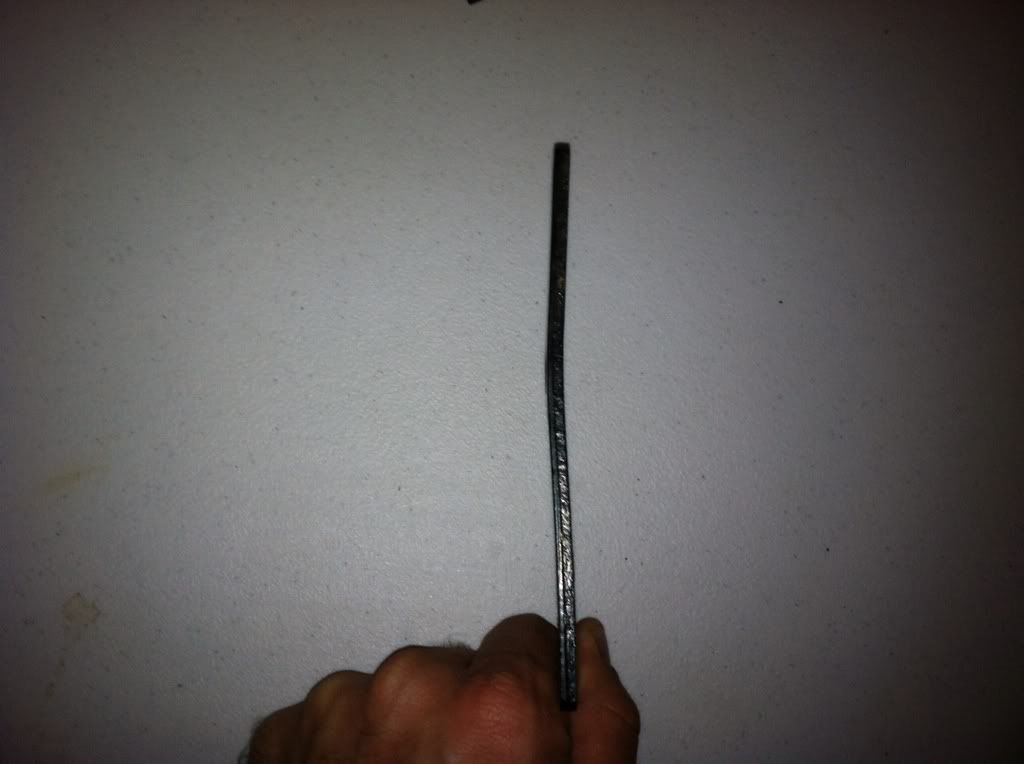
Bent plate and trailer side mini ball mount
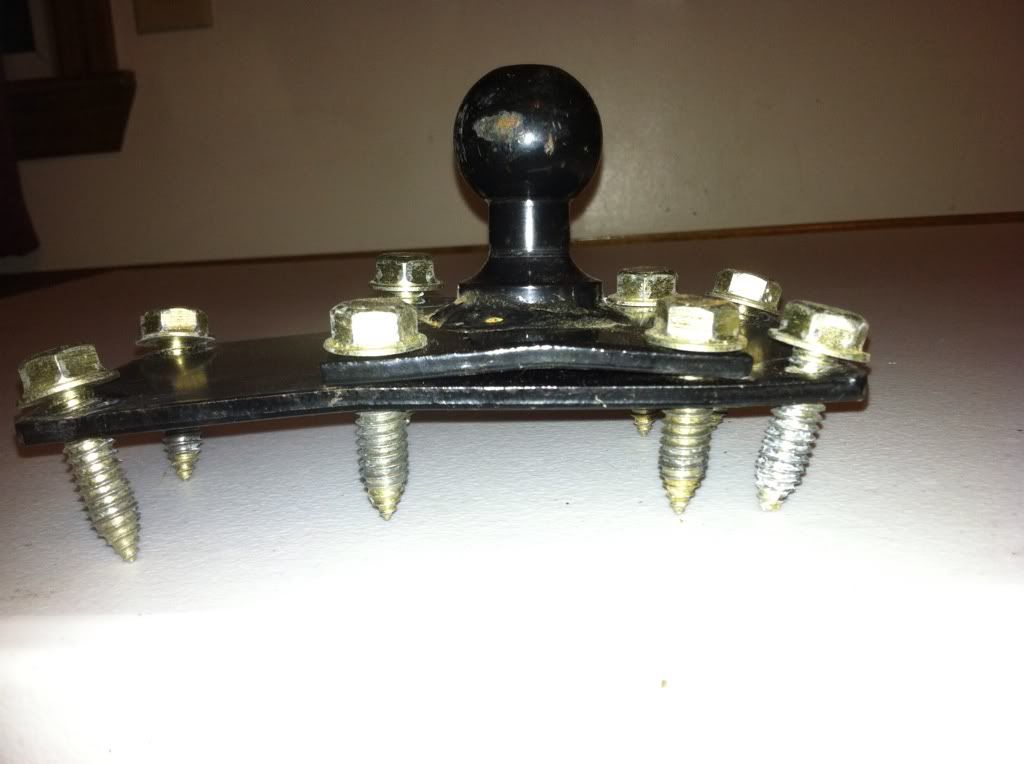
Sway bars attached ... the folly is apparent.. the drivers side is mounted too close to the coupler.
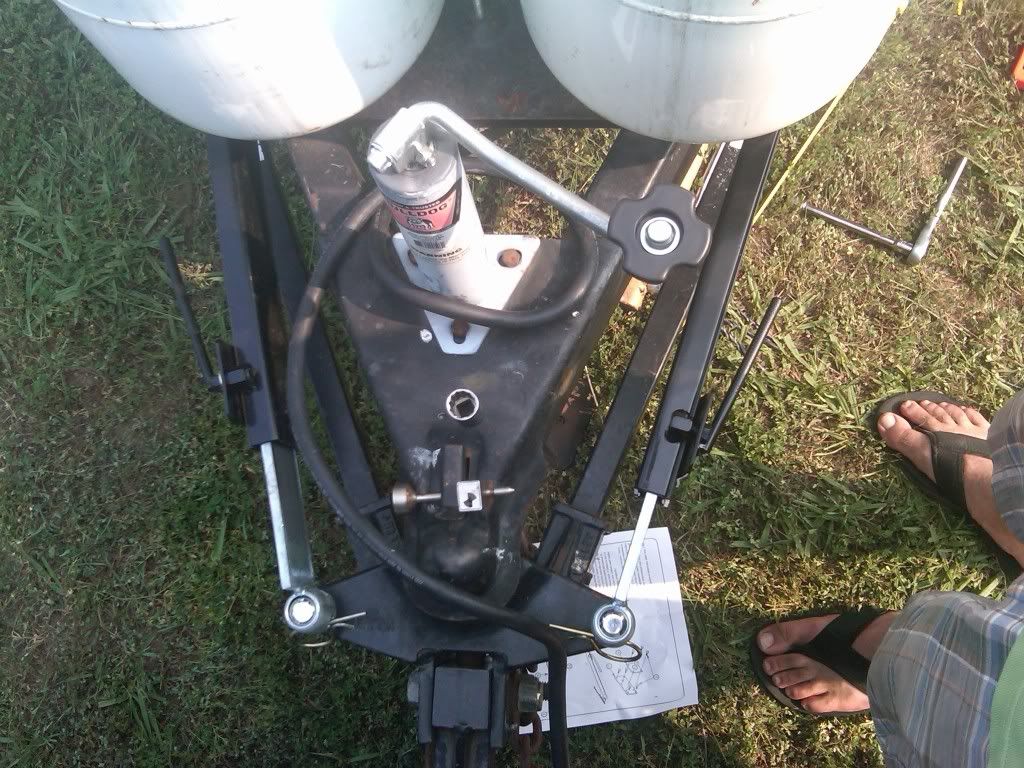
Here I measured the exposed sway slider portion of the sway bar. There is about 1/2 inch difference
Drivers side (street side?)
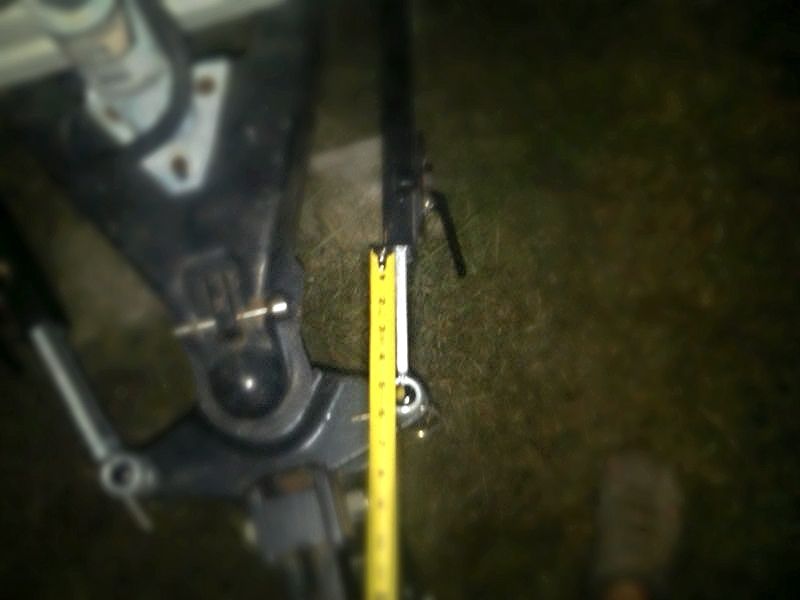
Passenger side (curb side)

NOTE: My bent mount happened when I was turning hard to the left pulling out of my driveway. The extra .5 inches was enough to let the sway bar crash into the miniball on the hitch head.
When I corrected my install I no longer had this problem.
Thanks!
Jeremiah
TT - Zinger 270BH
WD Hitch- HaulMaster 1,000 lb Round Bar
Dual Friction bar sway control
It’s Kind of Fun to do the Impossible
~Walt Disney~
- Mark as New
- Bookmark
- Subscribe
- Mute
- Subscribe to RSS Feed
- Permalink
- Report Inappropriate Content
Mar-07-2015 08:30 AM
gijoecam wrote:
snip... Something to note in your pictures is that at the extreme limits, it appears to me that if the drawback was actually mounted in a receiver, the bumper would be hitting the A-frame by the time the drawback reached the angle in your pictures.
Also, you mentioned there being a difference between a weight carrying and WDH head... if the sway control ball is installed on a weight carrying hitch head properly, the geometry is identical. In my case, I used an adapter plate that clamps between the ball and the shank, rather than welding the tab for the sway control ball.
Hi GI Joe,
Not disagreeing with you, just to show you the differences I am referring to with a WD hitch shank TT setup, verses a weight carrying draw bar on a PU setup, see here. My TT setup I could turn further then the PU setup and bend the friction bar on a left turn.
The WD hitch shanks are many times "longer" from the 5/8" pin to the tow ball then the standard weight carrying draw bar. The longer they are, the more turning you can do before the bumper hit the LP tanks. See here. Look at the hole in the hitch head for the mini ball and the relation to the centerline of the camper.
Your rig, Weight carrying short draw bar. The mini ball is straight out the center, your bumper about to hit the tongue jack. This is about all the left you want to do. But the friction bar is not yet hitting the side of the ball coupler. You have a 2" ball coupler.
Gijoecam top view pic
Now my WD hitch head. Mini ball is straight out the centerline of the camper. Bar hits side of coupler. Remember this is a 2 5/16" ball coupler, verses your 2" PU ball coupler. Mine is wider.

And now if I put the shank in the truck and turn, see the mini ball hole and see the A frame straight out the center of the camper. I have no jack on the side of the frame to hit, I can turn more but the mini ball will go past center and would of bent the friction bar. The longer WD shank allows this.
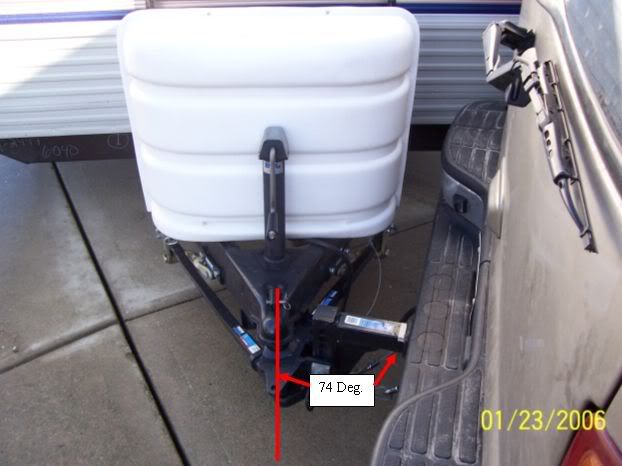
Trust me, you can bend up a WD hitch with turning too far just as easy as you can a weight carrying hitch.
As we both said, you have to know you equipment limits and understand them. Going forward or backwards does not matter. You can break them in both directions.
If more RV dealers would explain how hitch systems actually work and how to adjust and what to watch out for, camper folks would be a whole lot better off.
Most often, the hitch system gets "0" time during a PDI as compared to the camper. And these one size fits all "don't do that" with no explanation creates these urban myths and never explains where they came from. Reverse has nothing to do with bending the friction sway bar, max turning angle does.
Thanks
John
- Mark as New
- Bookmark
- Subscribe
- Mute
- Subscribe to RSS Feed
- Permalink
- Report Inappropriate Content
Mar-07-2015 04:39 AM
- Mark as New
- Bookmark
- Subscribe
- Mute
- Subscribe to RSS Feed
- Permalink
- Report Inappropriate Content
Mar-07-2015 04:32 AM
handye9 wrote:WyoTraveler wrote:
Are you referring to the single bar anti sway where they have 2 actual balls. A large ball for the hitch and little ball for one sway bar?
Yes, I think we're talking about the same kind of sway bar. Hitch head had 2-5/16 ball for the trailer and the little ball was mounted on a dog ear of the hitch head. There was another little ball welded on a plate that was screwed to the trailer frame. The damage consisted of the dog ear bending on the hitch head, the plate ripped off the trailer frame, and the friction bar bending.
Was it installed incorrectly, I couldn't tell you.
My old Draw Tite hitch had the same setup, I never had a problem either, but, I too had the warning from the dealer. I always removed to bar, for backing.
When I bought a new trailer, I did the install for the sway bar. Besides giving specific measurement for the plate on the trailer, the manual also had the warning about removing the bar for backing up.
There very well could be folks who have towed (for years) and backed up with the bar installed, and never had an issue. Maybe, it's luck, maybe it's a different brand that is built a little different. I don't recall the brand, but, I have heard of one that doesn't have that warning in the manual.
Here is a link to install instructions for a Reece sway bar. It says, on some installations the bar may need to be removed for backing up.
I guess the one I saw damaged, was one of those installations.
- Mark as New
- Bookmark
- Subscribe
- Mute
- Subscribe to RSS Feed
- Permalink
- Report Inappropriate Content
Mar-07-2015 04:21 AM
Check YOUR rig to see how tight it can turn before binding, but simply backing with them on won't bent them any more than driving forward will. As has been said, I always loosen them to stop the groaning (and I have 2 on mine, one on each side). We almost exclusively camp in "rustic" campgrounds, like Provincial and State parks, where the sites aren't uniformly rectangular, and don't have a pad to park on, and sometimes you have to back around sharply to get into a nice spot on the site. If I see that kind of site, I'll remove them just to be safe.
For me, the bottom line is, if it really bothers you, then go ahead and remove them before backing! You certainly won't miss the sway control while backing into a site! 🙂
2011 29' Kingsport 28RLS by Gulfstream
2013 Ford F150 Ecoboost 4X4 Supercrew
- Mark as New
- Bookmark
- Subscribe
- Mute
- Subscribe to RSS Feed
- Permalink
- Report Inappropriate Content
Mar-07-2015 02:40 AM
Also, you mentioned there being a difference between a weight carrying and WDH head... if the sway control ball is installed on a weight carrying hitch head properly, the geometry is identical. In my case, I used an adapter plate that clamps between the ball and the shank, rather than welding the tab for the sway control ball.
But the point stands: every rig is different. Learn the limitations of your rig and equipment.
- Mark as New
- Bookmark
- Subscribe
- Mute
- Subscribe to RSS Feed
- Permalink
- Report Inappropriate Content
Mar-06-2015 05:28 PM
This topics comes up often. I'll offer some of my thoughts.
When we bought our first pop up years ago, the dealer installed a friction sway bar and during our PDI the dealer told my wife and I the same thing, "Do not ever back up with the bar on". He had convinced my wife the hitch would explode if I ever attempted reverse...
This is also the same dealer that told us, "Never ever pull out the emergency break away cable. You do that and you have to pull the wheels off to reset the brakes and unlock them if you ever do"
Well, I just listened. After the emergency break away switch deal I knew the technical background of who I was dealing with. This guy is well...
On a weight carrying draw bar like a popup, they are more close coupled then on a WD hitch. As shown in the prior posters pic's the angles can be very extreme and not present an interference. However not all set up's are the same.
See here on a WD hitch. The WD shank is longer and can change the turning angles. Different conditions now.
Here is a right turn, 45 deg, no problem
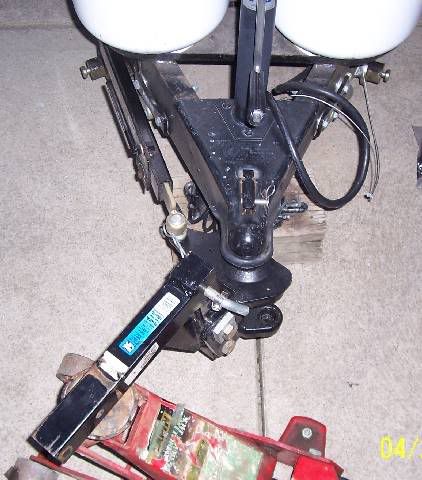
A left turn, 45 deg, no problem.
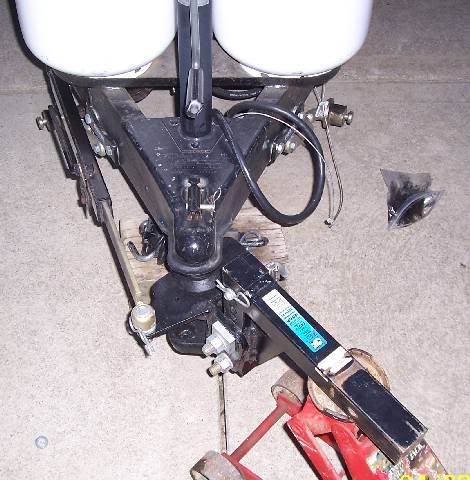
Now a 65 deg right turn. There is an interference. The mini ball will crash into the A frame. Friction sway bar to not, that is the limit of this hitch as that arm on the head will hit regardless.
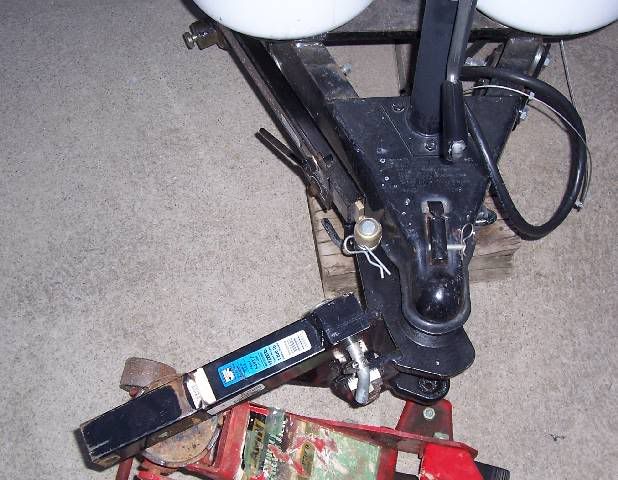
Now a 75 degree left turn. This will bend the bar on the coupler. And in this position my rear fender would almost be into the A frame. Since the shank is longer, I can turn left sharper then the popup with a short draw bar.

Point: Know the limits of your rig. Not all setups are the same. Under controlled conditions with a spotter, slowly back into the extremes, stop, get out and look. Memorize that position the sway bar is in. Then get back in the truck and look in the rear view mirrors and memorize what the trailer looks like at that extreme angle. Now armed with understanding, don't get that far going either forward or backwards.
On my rig, I can turn sharp enough going forwards to create the same issue as backing up.
The friction sway bar does not know which direction the TV is going, forward or backwards. If you approach the bind spots, forward or backwards, it can hit. It is "easier" for most rigs to get into these tight turns when backing up. So, the fear factor warning comes. Rather then explaining what is going on and why, some dealers use the fear factor explanation one size fits all and says, don't ever back up with the bar on. Now the owner leaves with no understanding of their hitch other than this extreme warning.
Another way the bar can get bent is the fast, extreme buckle of the bar where it can grab and bend the bar trying to collapse inwards. The conditions have to be right, very tight setting, collapsing very fast when the bar is fairly extended and the pads grab. The pads are bound enough that it is easier to bend the bar then to slip. This is condition LarryJ was explaining.
Hope this helps explain about the warnings and where they come from.
John
- Mark as New
- Bookmark
- Subscribe
- Mute
- Subscribe to RSS Feed
- Permalink
- Report Inappropriate Content
Mar-06-2015 10:46 AM
Lynnmor wrote:
You can cause the trailer to be at a greater angle when backing up.
So? Again, how does the sway control know?
You mean an angle like these, right?
 You have new Picture Mail! by gijoecam, on Flickr
You have new Picture Mail! by gijoecam, on Flickr You have new Picture Mail! by gijoecam, on Flickr
You have new Picture Mail! by gijoecam, on Flickr You have new Picture Mail! by gijoecam, on Flickr
You have new Picture Mail! by gijoecam, on Flickr You have new Picture Mail! by gijoecam, on Flickr
You have new Picture Mail! by gijoecam, on FlickrIf you ever get to that extreme angle when backing the trailer in, and it's NOT a 5th wheel, you're going to have to pull forward again anyways. If the sway control is properly installed, it can neither bottom out nor hyper-extend when backing at extreme angles. On this particular popup, the only thing it could contact would be the safety chain tab on the frame, and only then if the truck was at a pretty extreme angle to the trailer.
So, I repeat the question: How does the sway control know which direction the rig is travelling? More importantly, why does it care?
The answer to both is: It doesn't.
I think this is one of those old wive's tales that many people buy into carte-blanche without giving it any consideration. Yes, it's possible to jack-knife a trailer tighter in reverse than in forward... But the device itself functions exactly the same regardless of the direction the rig is travelling. It *can* be the limiting factor if it's either not properly installed or if it contacts another component moving through its range of motion (like the chain attachment points in my photo above).
As someone mentioned earlier in the thread, every rig will be a little different. Learn your rig's limits. If it's necessary in extreme maneuvers, take it off. Otherwise, there is no need to.
- Mark as New
- Bookmark
- Subscribe
- Mute
- Subscribe to RSS Feed
- Permalink
- Report Inappropriate Content
Mar-06-2015 02:50 AM
BossCamper wrote:humblerb wrote:
When we bought our first TT about 5 years ago, we were warned during our walk-through that we should always remove the sway bar prior to backing with the trailer. Even if we were backing just a little bit. The salesman told us that backing with the sway bar connected would destroy it. He claimed that he had seen them come back in bent in half. He stressed the importance of removing it very strongly.
We have always tried to remember to remove the sway bar before backing the trailer. But there have been a few occasions where I just started backing without thinking about it.
The only problem I have encountered was once when one of the cotter pins got in a bind and it was destroyed. Never had a problem with the bar.
Does anyone know the reason for the strong warning? Is it because you can get the bar in a bind if the turn is tight? I can't think of any other reason, but not sure if there is something I am not thinking of.
Thanks for any thoughts.
I'll assume you're talking about friction sway bars.
They can get bent during an extremely tight turn where they are either completely compressed and forced further, or on the off side, bound up against the hitch, and then forced past that point.
I have checked in my driveway, and on my setup, I can't turn tight enough to bind them before the corner of my truck box hits the trailer. You could check that out on your own rig. Obviously, best practice will be to take them off.
I always loosen mine as soon as I get into the CG so they'll quit moaning on every turn. Once I get to my site, I remove them ... most of the time .... but if I forget, they will still slide loosely because I have backed them off.
I used a friction bar for over 20 years and actually wore one out and did bend one, but on careful anaylsis understood why it happened. Under normal usage as already noted it is not necessary to remove it. It doesn't hurt to loosen it like when manuevering into a camp site where you are doing a lot of backing, etc. Where you run the potential of bending one is when you have it in an extreme extended condition and go in the opposite direction too quickly. The time I bent mine I was pulling out of a parking lot where there was a significant "DIP" right at the highway entrance and I was turning a a good angle and had the bar extended and had just started out onto the highway and had to back up which I did suddenly and the bar was bent since I was trying to force the 12 or 14" of bar back in between the two friction pads way too quickly and there was a lot of weigh from the trailer adding top the interia along with the bar not being totally straight.
As long as you understand and use them within reason they are a fine system for the smaller 20 to 25' and under lighter trailers.
Larry
Larry
RAINKAP INSTALL////ETERNABOND INSTALL
- Mark as New
- Bookmark
- Subscribe
- Mute
- Subscribe to RSS Feed
- Permalink
- Report Inappropriate Content
Mar-06-2015 02:19 AM
gijoecam wrote:
Please explain how a standard friction away control has any idea which way the rig is travelling and how the direction of travel changes the function of the device in such a way that it (the direction of travel) causes the failure? How is moving the rig backwards going to cause it to fail when moving forward doesn't?
You can cause the trailer to be at a greater angle when backing up.
- Mark as New
- Bookmark
- Subscribe
- Mute
- Subscribe to RSS Feed
- Permalink
- Report Inappropriate Content
Mar-05-2015 05:51 PM
Thanks!
Jeremiah
TT - Zinger 270BH
WD Hitch- HaulMaster 1,000 lb Round Bar
Dual Friction bar sway control
It’s Kind of Fun to do the Impossible
~Walt Disney~
- Mark as New
- Bookmark
- Subscribe
- Mute
- Subscribe to RSS Feed
- Permalink
- Report Inappropriate Content
Mar-05-2015 04:58 PM
- Mark as New
- Bookmark
- Subscribe
- Mute
- Subscribe to RSS Feed
- Permalink
- Report Inappropriate Content
Mar-05-2015 04:39 PM
randallb wrote:
The hitch manufacturer will let you know if their sway control can remain installed when backing up. If they say no backing up they mean it. The hitches that allow backing are usually the ones with the sway control built in to or on to the end of the bars. The hitches that you should not back up usually have the separate sway (friction) controller that mounts between the hitch head and the trailer tongue. If you do not disconnect the sway control you will be replacing the weak link when it bends. Hopefully the weak link is the sway controller not the hitch head or the tongue.
Randy
Please explain how a standard friction away control has any idea which way the rig is travelling and how the direction of travel changes the function of the device in such a way that it (the direction of travel) causes the failure? How is moving the rig backwards going to cause it to fail when moving forward doesn't?
- Mark as New
- Bookmark
- Subscribe
- Mute
- Subscribe to RSS Feed
- Permalink
- Report Inappropriate Content
Mar-05-2015 04:12 PM
Randy





